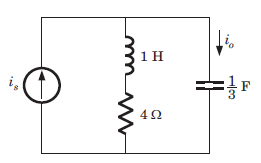Electrical Engineering (EE) Exam > Electrical Engineering (EE) Tests > Test: Circuit Analysis in the s-Domain - Electrical Engineering (EE) MCQ
Test: Circuit Analysis in the s-Domain - Electrical Engineering (EE) MCQ
Test Description
10 Questions MCQ Test - Test: Circuit Analysis in the s-Domain
Test: Circuit Analysis in the s-Domain for Electrical Engineering (EE) 2025 is part of Electrical Engineering (EE) preparation. The Test: Circuit Analysis in the s-Domain questions and answers have been prepared
according to the Electrical Engineering (EE) exam syllabus.The Test: Circuit Analysis in the s-Domain MCQs are made for Electrical Engineering (EE) 2025 Exam.
Find important definitions, questions, notes, meanings, examples, exercises, MCQs and online tests for Test: Circuit Analysis in the s-Domain below.
Solutions of Test: Circuit Analysis in the s-Domain questions in English are available as part of our course for Electrical Engineering (EE) & Test: Circuit Analysis in the s-Domain solutions in
Hindi for Electrical Engineering (EE) course.
Download more important topics, notes, lectures and mock test series for Electrical Engineering (EE) Exam by signing up for free. Attempt Test: Circuit Analysis in the s-Domain | 10 questions in 10 minutes | Mock test for Electrical Engineering (EE) preparation | Free important questions MCQ to study for Electrical Engineering (EE) Exam | Download free PDF with solutions
Test: Circuit Analysis in the s-Domain - Question 1
What will be the response for the below figure?


Detailed Solution for Test: Circuit Analysis in the s-Domain - Question 1
Test: Circuit Analysis in the s-Domain - Question 2
The current response of a network to a unit step input is Io(s) = 10(s + 2)/s(s2 + 11s + 30). The response is
Detailed Solution for Test: Circuit Analysis in the s-Domain - Question 2
Test: Circuit Analysis in the s-Domain - Question 3
The network function (s2 + 8s +15)/(s2 + 6s + 8) is
Detailed Solution for Test: Circuit Analysis in the s-Domain - Question 3
Detailed Solution for Test: Circuit Analysis in the s-Domain - Question 4
Test: Circuit Analysis in the s-Domain - Question 5
The network function (s + 1)(s + 4)/s(s + 2)(s + 5) represents
Detailed Solution for Test: Circuit Analysis in the s-Domain - Question 5
Test: Circuit Analysis in the s-Domain - Question 6
The network function (s2 + 4s)/(s + 1)(s + 2)(s + 3) represents
Detailed Solution for Test: Circuit Analysis in the s-Domain - Question 6
Test: Circuit Analysis in the s-Domain - Question 7
What is the ratio of the transfer function Io/Is?

Detailed Solution for Test: Circuit Analysis in the s-Domain - Question 7
Test: Circuit Analysis in the s-Domain - Question 8
The voltage response of a network to a unit step input is Vo(s) = 10/s(s2 + 8s + 16). The response is
Detailed Solution for Test: Circuit Analysis in the s-Domain - Question 8
Test: Circuit Analysis in the s-Domain - Question 9
The network function s^2 + 10s + 24/s2 + 8s + 15 represents
Detailed Solution for Test: Circuit Analysis in the s-Domain - Question 9
Test: Circuit Analysis in the s-Domain - Question 10
The network function (3s2 + 8s)/(s + 1)(s + 3) represents
Detailed Solution for Test: Circuit Analysis in the s-Domain - Question 10
Information about Test: Circuit Analysis in the s-Domain Page
In this test you can find the Exam questions for Test: Circuit Analysis in the s-Domain solved & explained in the simplest way possible.
Besides giving Questions and answers for Test: Circuit Analysis in the s-Domain, EduRev gives you an ample number of Online tests for practice
Download as PDF



















